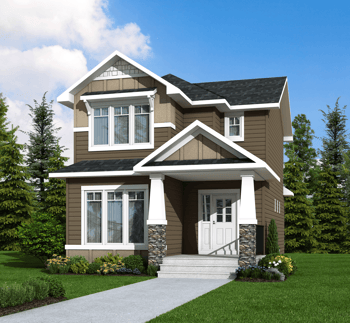
If you’re puzzled about whether to build a detached or attached garage with your new home, you’re not alone. Each design has its benefits, but only one is best suited for your particular needs.
From a Financial Perspective
When comparing attached versus detached garages, you may be wondering what the difference in cost is. This is not something that can be answered with one single calculation, as the overall cost of your new home build will vary for a number of reasons. However, generally, the price differences between the types of garages alone is actually not very significant.
If you’re considering homes with front-attached garages, the “price to build” the garage will simply be included in the total price of the existing home or of new construction. If you’re considering homes without attached garages, this is where you’ll notice variances.
A home without a garage – not even a detached one in the back – will be less expensive than a comparable home with a garage. Of course, when you do choose to have a garage built in the back of a detached home, you’ll be paying more. This is pretty straightforward. But the interesting thing you’ll notice is that the overall cost of a home plus a detached garage is likely to be quite similar to the overall cost of a home with a garage already attached.
Additionally, some people perceive that a detached garage is a lesser product, but in actuality, the quality is the same. Thus, the only real difference is location. For this reason, your final decision will likely be one based on lifestyle and preference more than cost.
Questions to Consider
The decision to build one or the other can be resolved by answering the following questions:
- Which garage best suits the size of your existing lot?
- How do you intend to use the garage — for vehicles only or for additional storage or projects?
- Which style will complement your existing landscape or view?
- Will the garage blend or clash with your home’s architectural features?
- Will its location protect or expose you to inclement weather?
- How vulnerable is the structure to potential break-ins?
It Has to Fit Your Existing Lot
The size and orientation of your lot will determine how big your garage can be and where it will be situated. Make sure your new garage fits comfortably on the lot without dwarfing your house or infringing on a neighbour’s property. If it’s detached, you want it built close enough to the main house to make it accessible, but also far enough away to provide some green space for play or easy outdoor entertaining.
A standard two-car garage measures 24 feet wide by 24 feet in length with an 18-foot wide door, easily accommodating most vehicles and allowing more than two feet of walking space around cars. You also want to have ample room to store trash bins, tools, a riding lawnmower, or a snow blower without clutter. A good ceiling height for detached or attached garages is 10 feet, capable of accommodating an SUV or standing ladders in an upright position.
The placement of existing walkways, driveways, and easements will dictate where a concrete footer and slab can be poured —all in compliance with Canadian building planning and zoning codes. In order to obtain a building permit, your builder will have to furnish a set of blueprints to the Building Commission which include drawings of the proposed elevation, floor plan, electrical wiring, plumbing, roofing system, and construction details.
 A Detached Garage
A Detached Garage
Enhanced Curb Appeal
A standalone garage can enhance the appearance of your home site and make a lot look much like a mini estate. Your builder may even be able to construct a detached garage with the same architectural details as your house. A home site with one or more outbuildings looks impressive, expansive, and has great curb appeal. Since there’s some distance between the house and a detached garage, you may want to tie house and garage together aesthetically with a wrought iron or picket fence and a flagstone, brick, or paved pathway.
A Better Option for Infill Neighbourhoods
Residential contractors did not begin adding attached garages until the late 1970s, so detached garages remain a staple in older neighbourhoods. Infill development may even require homeowners to build garages consistent with the style and feel of a vintage neighbourhood. Your builder can add architectural features like corbels, cedar shakes, or lap siding to make a new garage look decades old.
Safer Storage for Flammable or Toxic Materials
If you're adamant about including safety features in your new home build, you may prefer storing gas for lawnmowers and power tools, fertilizer, or caustic chemicals in a detached garage several feet away from the house. You don’t have to worry about fires, caustic fumes, or toxic gases entering a shared space or wall. In the case of a fire, flames are more easily contained or extinguished when the garage is not attached to your house.
The Con:
A detached garage may look great, blend in with an older neighbourhood, and provide safer storage for flammables; but its relative distance from your house may pose problems, especially when the weather is bad. By the time you’ve made dozens of trips between the house and garage, a detached unit may seem less attractive.
 An Attached Garage
An Attached Garage
Easily Accessed
Building a garage onto your house can also enhance its overall curb appeal, depending on your preferences, but the real appeal is that it will provide convenient access to your home’s interior. An entrance from the garage through a mud room or walk-through pantry to your kitchen makes carrying loads of groceries from the car to the house a breeze.
Protection from Bad Weather
In inclement weather, an attached garage is indispensable, providing shelter from the wind, snow, cold and rain. No more getting drenched trying to make your way into the house! An attached model also keeps vehicles free of ice and snow —saving you time, money, and wear and tear on your car.
Safety Against Break-Ins
Vehicles housed inside an attached garage may be more difficult for thieves to break in. It’s much easier to hear an alarm going off in the middle of the night if your garage shares a wall with the house.
The Con:
The fact that your garage is attached can be detrimental in the case of a fire or break-in. That shared wall could easily become vulnerable to smoke, fumes, or flames entering your residence. Thieves can also gain entrance to your house through an open garage door.
The Solution
Consult with your qualified builder and consider short- and long-term options for a garage that best suits your needs. As one of the advantages of working with a Calgary home builder, your builder is qualified to offer viable, code-compliant plans – you just have to decide which type of garage will most benefit you and your family.
Originally published July 25, 2017, updated March 12, 2018.





